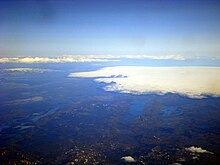Tungnafellsjokull
| Tungnafellsjokull | ||
|---|---|---|
|
Tungnafellsjökull seen from the west |
||
| height | 1535 m | |
| location | Iceland | |
| Coordinates | 64 ° 44 ′ 8 ″ N , 17 ° 54 ′ 18 ″ W | |
|
|
||
| Type | Crevasse volcano | |
| Age of the rock | approx. 800,000 years | |
|
Tungnafellsjokull |
||
The Tungnafellsjökull with an area of about 48 square kilometers one of the smaller glacial Islands . It is about 10 km long and 5–6 km wide. The highest point of the glacier is at 1535 m.
location
It is located on the Sprengisandur highland slope northwest of the glacier shield of Vatnajökull and west of the closest central volcano Bárðarbunga, which is located under Vatnajökull .
The high valley Vonarskarð with its high temperature area belongs to the volcanic system of Tungnafellsjökull and lies between it and Vatnajökull.
shape
It is a volcano that consists largely of palagonite , i. H. formed under glaciers.
The sides of the glaciated mountain range are steep in the south and west.
The highest peak called Háhyrna is on the west side of the mountain. From there you have a good view of Vonarskarð and Sprengisandur.
Volcanism
This is a large central volcano whose volcanic system includes some crevices in the lowlands. Geologically, it is located on the west side of the Eastern Volcanic Belt of Iceland.
Its shape is roughly circular with a diameter of 20 km and the volcano extends to Vonarskarð . In the west of the volcanic building a small stratovolcano had formed similar to that of the Hekla. But later it collapsed and a small caldera appeared, which is filled with glacial ice. Another small caldera on the east side is badly eroded.
There are no records of outbreaks since Iceland was settled. The volcano is classified as active, however, because it has erupted several times in the last 10,000 years, as can be demonstrated by ash layers and rows of craters emanating from it.
Of the volcano's two calderas , one is covered by the glacier, the other is exposed. In it you can recognize rhyolithic lavas.
Numerous columns with overlying palagonite ridges extend from the central volcano to the southwest and thus follow the main orientation of the active volcanic zone. Slightly fewer and more difficult to identify columns, however, can be found in the north of Tungnafellsjökull.
The Hágöngur volcano in the southwest of the glacier belongs to the same volcanic system as the high-temperature areas on Vonarskarð. The volcanic system extends to the southwest as far as Þveralda east of the Sprengisandur slope.
Exploration and first ascent
Ina von Grumbkow's travel companion and future husband , Hans Reck , was the first to examine the glacier, as far as is known, in 1908.
The first ascent was made by the Swiss Hermann Stoll in 1911.
If you want to climb the Háhyrna peak, you drive from Nýidalur on the Sprengisandur to the Hagakvíslar (866 m) and climb up from there.
See also
Individual evidence
- ↑ a b Íslandshandbókin. 2. bindi. 1989, p. 908
- ↑ a b Ari Trausti Guðmundsson, Pétur Þosteinsson: Íslensk fjöll. Gönguleiðir á 151 tind. Reykjavík 2004, p. 292
- ↑ a b Hjörleifur Guttormsson, Oddur Sigurðsson: Leyndardómur Vatnajökuls. Viðerni, fjöll and byggðir. Reykjavík 1997, p. 73
- ^ Tungnafellsjökull in the Global Volcanism Program of the Smithsonian Institution (English); Retrieved September 20, 2010
- ↑ Íslandshandbókin, ibid .; see. also Hermann Stoll: Across Iceland. Yearbook of the Swiss Alpine Club, vol. 1910, pp. 154-186
Web links
- Tungnafellsjökull in the Global Volcanism Program of the Smithsonian Institution (English)
- Recent movements in Tungnafellsjökull fissure swarm , Univ. of Iceland, Feb. 2012 (abstract )
- Skiing on the Tungnafellsjökull (English)



